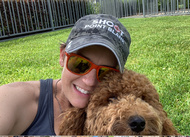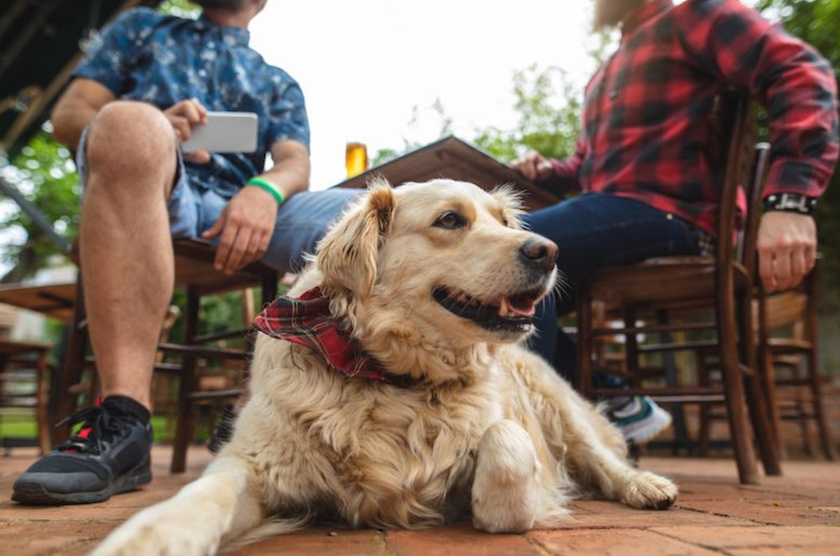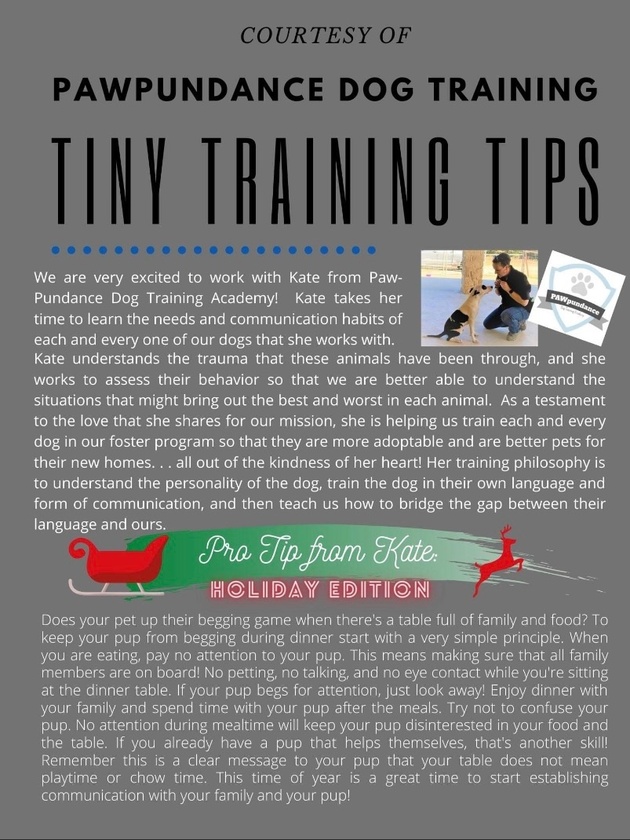
It’s ok! We’re here to help. We speak a little dog and can help translate for both of you. It’s probably just a miscommunication! And we are here to help get you both speaking the same language! Woof!
Connect with the PAWpundance training team and other members of the dog community to discuss better ways to communicate with your furry house guest.
**To get started USE code: TRIAL1month **
Lulu was a pup that really struggled with having a LOT of energy. So we needed to work on impulse control. She also didn't have a whole lot of tools in her tool box to make her family happy. She was still a puppy and just didn't know what behaviors (sit, down etc vs jump, bark) to try to get attention. So far the behaviors that yielded the most attention were the high energy behaviors. There is a reason those high energy behaviors work, she's trying to get your attention!
So train YOU!
Training the families to give attention to the calm behavior (sit, down, relax) and to simply NOT give attention to all the inappropriate behavior is a major mindset change.
Scott Adams post on his community on Locals on 5/27/20 a video of him and his pup Snickers. He shows a bowl of food from which Snickers can free feed. Once he takes a piece of food from the bowl, Snickers immediately gets excited and responds by sitting as if the food in his hand is a treat... What changed? The attention. The power of attention is very important. And we need to use it very wisely.
I learned very early on in my training career the power of training and cell phones. I can NOT even glance at my watch to check a notification in the middle of a learning session with a pup. The break in attention is seen as punishment and the pup with second guess the whole learning segment and we will back peddle on that session. Wow was that glance worth it? I became much "cleaner" about my notifications and about what electronics were allowed to disrupt me. I made my voicemail clear that I don't disrupt a training for a phone call - when it's your pup - you'll be happy for my consideration. Nothing is so urgent.
I learned to become this attentive with my human conversations as well - for the most part. I found, if I stayed engaged until, like the pups, the other person indicated they were "done" talking. I was surprised how many people seemed really happy to have genuine attention. In the cases where I did need to take a call (communicate with my husband etc), the disappointment in the moment was very clear. I am not perfect in my attention. But I strive to focus on the people that are important to me. And no attention to poor behavior. Enough said. No attention.
How did we get Lulu to do this? She was a smart pup!
Every pup we work with is different. There is no one-size-fits-all approach to teaching each move. Learn how to build a system. Learn how to capture a behavior or shape etc. Then add a cue. Know when to use a physical vs. verbal or physical cue. It is never a pattern. You write it based on your dog. No copy and paste. Explore systems! Fundamentals where it's at in any field!
Lulu knew a down at this point. I had a treat. I wanted calm behavior from her. I sat down and waited. I started by rewarding her for a couple downs to put her on the right track. When she jumped or gave excited behavior, I turned away. (Kind of like playing the game warmer/colder). Eventually when she was in a down, I cheered her on and told her she was doing a good job and to keep going. But no treat yet. She needed to keep thinking of a behavior to throw. Eventually she gave up and put her head down. Click! And here's the key to this - reward her while her nose is near the ground. I didn't know to ALWAYS do this back then. I know it now. It's as important where you treat as when you click. The "when" of the click tells the pup this exact moment is the thing I was looking for - Great Job!! And the where of giving the dog the treat is important because they will most likely go to that spot when they "throw" behavior. If you always give dogs treats while they are jumping, even if it's following a calm behavior, they will "throw" jumping later when they want food. If you give the dog food in a "down" regardless of the behavior that was "clicked", they will assume you want the down position when they just don't know what you want. Sounds better than jumping huh?
My house is funny. I have reverse jumping going on. My big,excited dogs will run to you and throw themselves into a down then stand up and throw a down again to get your attention again. It all started when we got a new puppy. We need to get back to calm responses, impulse controlled - but right now we are laughing at reverse jumping.
Eventually Lulu figured out that I was rewarding her head on the ground. I was able to put a cue on it. We skipped the gesture and just gave it a verbal cue. She is just such a smarty anyway - she got it right away. Then I did push it with a wait. The best practice is to end with a Jackpot!! And restart again on the next session.
This pup was tough because she learned so darn fast! At the time I didn't know how quickly to move. I didn't want to bore her but like this, if you push too hard - it's confusing.
The trick is to have each session broken into single increments. The intensity of the increments is based on the dogs ability. If the pup is not ready to stop training but has already reached a milestone in that category, change it up. Move to another element. As soon as her behavior is fidgety call it. End of session. You can snuggle or play if you still have "time left" on your session. But trying to train more will undo any work. Short, frequent, regular sessions are better than long, stressful ones. Again - Systems!
Training Lulu was one of the greatest joys I had as a trainer because she is so smart. I loved watching her doing this later. She did a version of "push-ups" where she was just lifting her head up and down in rapid succession and it was impressive. She's a great pup!
Learning relax is not only good for calm behavior but like with another pup we work with, Ted, it can help with barking. Like jumping, barking is one of those behaviors that is hard to just throw out the window and erase. Sometimes instead of voiding out a behavior, we work on swapping a behavior with another that conflicts. So in the case of my reverse jumping dogs. They were still excitedly throwing themselves at me. And they still need to work on calm. But for big dogs, I would rather have them "falling at me feet" in excitement than knocking me over. And it's impossible for my dogs to jump and be down at the same time. So we tackled jumping by replacing with a down.
With Ted, we worked on relax and over (rolling over on his side) because he had a hard time physically making his trademark, high-pitched bark in these positions. They came out more like Chewbacca. And it became something we could work to replace. Plus the new noise was silly and way more pleasant communication than the shriek he had before.
Remember each pup will learn this differently. Please ask questions. Send us videos. Reach out. Need help Writing that system... That's what we're here for! Let's to this together!
Relax! We got this!!
Welcome to PAWpundance Dog Training Academy on Locals.com!
We’re thrilled that you’ve joined our community! PAWpundance is a place for positive, dog-loving people to come together, share experiences, and help each other grow. Locals offers an “ad-free experience,” so even a small contribution helps support our tech and keeps our community thriving.
We want to see your furbabies!
We’re here to assist with any questions you may have about training, behavior, and more. At PAWpundance, we believe in blending knowledge with a bit of fun—expect plenty of paws, puns, and maybe even a dance or two! Together, let’s enjoy some laughs and build stronger relationships with our pups.
Our Philosophy:
We’ve invited another species to live in our homes, and our dogs are much more than accessories; they’re our guests. They don’t speak our language, and like in the movie E.T., we don’t want to be the intimidating figures trying to coerce a scared, confused being. Instead, we want to be like ...
Eye Contact, Eye Contact, Eye Contact!
Reward every glance. Start by reinforcing brief glances, then encourage your pup to hold your gaze a bit longer. Gradually phase out your part of the eye contact—your pup will learn to watch you and adapt to your movements naturally. This approach helps them learn to walk with you without relying on leash cues.
Remember, the leash is purely for safety—not for communication.
Take a look at this video with Meghan and Buckee. Buckee is watching Meghan closely, and she rewards him by making eye contact, smiling, and offering treats. Meghan also looks forward occasionally, teaching Buckee to walk with her in sync.
Notice that Buckee is a reactive pup, so the leash is essential for safety, especially if he responds to something unexpectedly. However, it’s only used for physical control when necessary. When Buckee refocuses, Meghan reestablishes instructional control, and they continue their walk together. She does a fantastic job of engaging with him! In ...
Loose-Leash Walking Tip:
Where you reward makes a big difference! Try using the hand on the same side as your dog when giving treats or praise.
When you reach across your body to reward with the opposite hand, it draws your dog’s nose in front of you, encouraging them to move ahead and potentially start pulling.
In the video of Meghan and Domino, Meghan holds the leash with her left hand while Domino walks on her right. She rewards him by petting and giving treats with her right hand. This keeps Domino walking by her side on a loose leash, rather than in front, pulling her along.
Next time you’re out walking with your pup, try rewarding with the hand on the same side as your dog.
https://twitter.com/wholedogjournal/status/1295508215740932098?s=21
How to teach you pup to be a good dining companion! What a great skill!

https://twitter.com/wholedogjournal/status/1292609106637987840?s=21
This is about counter-surfers, but I love the description of trying to shame dogs. This author, Pat Miller helped me understand this concept in her book the Power of Positive Dog Training.
If you’re still on Twitter, the Whole Dog Journal is a great group to follow. Lots of fantastic info!













